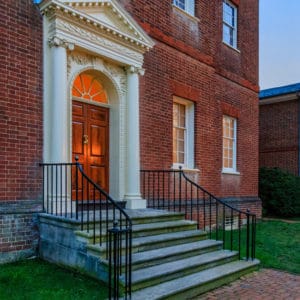
Annapolis is famous for its colonial charm and historic houses. At the time of its so-called “Golden Age,” from the late 1750s to 1776, Annapolis was described as the “genteelest town in North America.”
To this day, our downtown is home to a greater density of original 18th-century buildings than any other U.S. city, making it a wonder of colonial architecture. Many of these homes are available for tours, including the mansions of three signers of the Declaration of Independence – Samuel Chase, Charles Carroll of Carrollton, and William Paca.
Although not currently open to the public, some of these remnants of our city’s past “Golden Age” have gone virtual, so you can now follow them through their blogs or Facebook pages.
Hammond-Harwood House
The Hammond-Harwood House is home to some of the finest examples of decorative and fine arts in Maryland. Some of their treasured items are those that were here in the 19th century when the house was still a private residence. Other highlights include a large collection of paintings by Charles Willson Peale and other members of the Peale family, seventeen in total, and twenty one furniture pieces by the well-known Annapolis cabinetmaker John Shaw. On the Hammond-Harwood House Facebook page, docents share some of their favorite pieces of art, architecture, and the fine examples of craftsmanship exhibited in the house.
William Paca House and Gardens
Historic Annapolis’s seminal project was restoring and opening the grand colonial home and garden of William Paca, a signer of the Declaration of Independence. Other preservation efforts saved the more modest living and work spaces of early artisans and merchants. On their Facebook page, Historic Annapolis will share its curators secrets with #CuratorsCorner, tours of their gardens with #TodayInTheGarden, and updates from their expert staff with #WorkFromHomeWednesday.
Historic London Town and Gardens
London Town was founded in 1683 as Anne Arundel County’s seat. Its heyday lasted approximately 100 years. The only remaining historic structure on site is the William Brown House. Built in c.1760 as an upscale tavern, the William Brown House became the county’s almshouse from 1828 – 1965. Today it is the centerpiece of the site’s historic area, which also includes a reconstructed Carpenter’s Shop and Lord Mayor’s Tenement with kitchen garden, ropewalk, and an 18th century tobacco barn. Follow Historic London Town’s blog to read about their Tavern Tales, historic secrets, and other items of interest.
Looking for more information on these homes and more? Take the Four Rivers Heritage Area’s Virtual Tour through the “Golden Age” of Annapolis Architecture.
